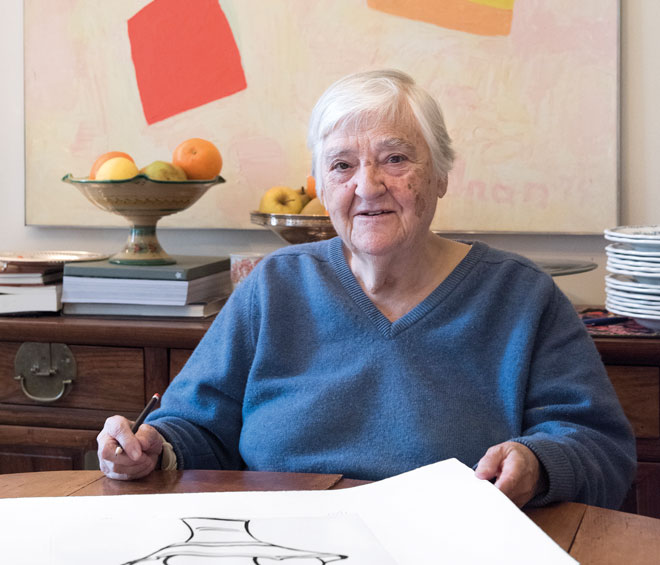
Etel Adnan. Copyright Etel Adnan, courtesy Galerie Lelong & Co. Paris.
Zentrum Paul Klee, Bern
15 June – 7 October 2018
by VERONICA SIMPSON
Etel Adnan (b1925, Beirut) is a poet and philosopher whose epiphany on the joys of painting and colour came through Paul Klee, originally a musician, who never thought he could master painting until his own epiphany. It was while travelling in Tunisia, in that vivid landscape that was like his Swiss homeland in one respect (mountainous) and yet so different, that Klee understood the power of colour and light as mediums for translating and transforming emotions, atmosphere and perception. Both Adnan’s and Klee’s work - as with music and poetry - excels in exploring the tension and release of consonance and dissonance, unexpected adjacencies, subtle or dramatic variations in tone, rhythm, form and light; a mining of both physical and emotional landscapes via the most essential and expressive hues and gestures to place “the visible at the service of the invisible”, as Odilon Redon once said.
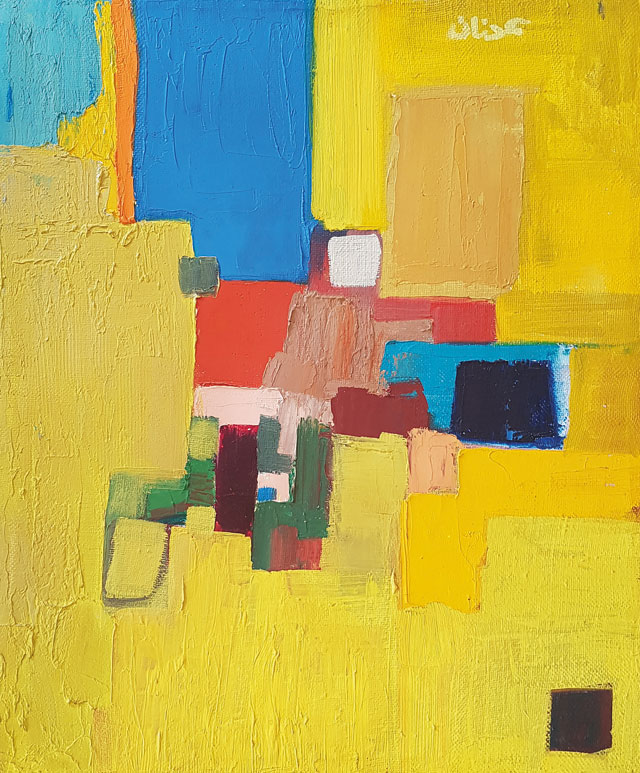
Etel Adnan. Untitled, 1960s. Oil on canvas, 45.8 x 38.3 cm. Courtesy the artist and Sfeir-Semler Gallery, Hamburg / Beirut.
Adnan was discovered by the wider world late in her life (around 2012 at Documenta 13, when she was nearly 90), and her many interrogations into the potency of words and pictures are harvested most eloquently in this show at the Zentrum Paul Klee. Curators Sébastien Délot and Fabienne Eggelhöfer offer us the full breadth of her work, from beautifully lit leporellos to grainy videos made in the 70s, from paintings to tapestries, occasionally punctuated by works of Klee’s from the Zentrum’s collection - approved by Adnan – to create a gentle dialogue.
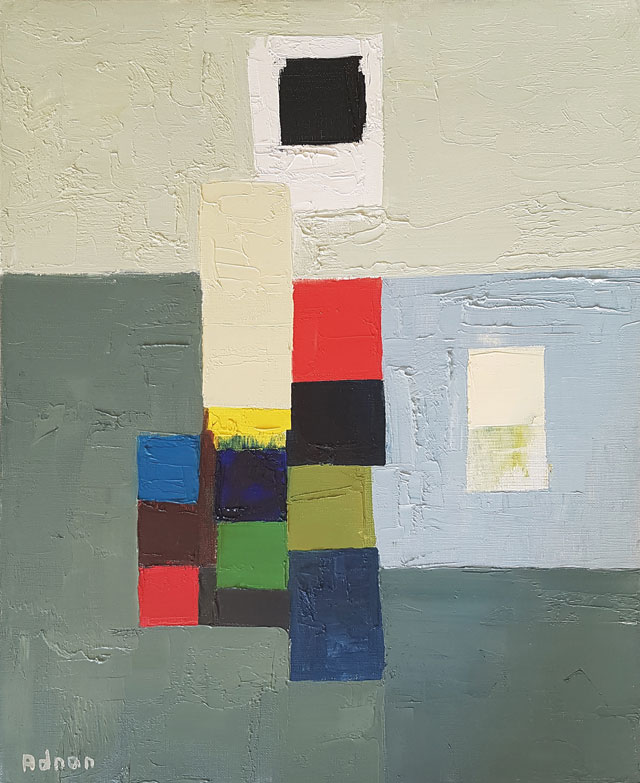
Etel Adnan. Untitled, 1970s. Oil on canvas, 46.4 x 38 cm. Courtesy the artist and Sfeir-Semler Gallery, Hamburg / Beirut.
The significance of language and place, of culture and context are perhaps inevitable preoccupations for Adnan, given her background: her Christian Greek mother and her Muslim Syrian father, a high-ranking officer in the Turkish army, fled from Smyrna to Beirut after the fall of the Ottoman empire, and that’s where Adnan was born. Educated in Beirut at a French convent school and then at the Sorbonne in Paris, she moved to the US in 1955 and started teaching philosophy in California. It was here, in the 60s, that she discovered Klee, when his notebooks (Paul Klee Notebooks – lectures from his Bauhaus teaching in the 20s) were translated into English, and then at a major retrospective in 1967.
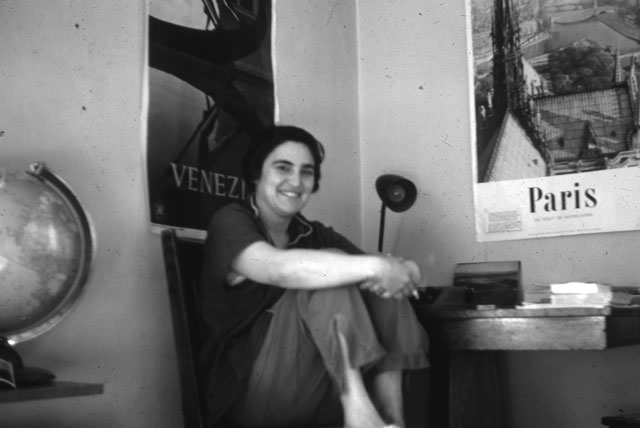
Etel Adnan in her student room
at the University of California, Berkeley, c1955. Copyright Etel Adnan.
She began to paint and draw herself, creating abstract compositions with colours often squeezed direct from the tube, playing with the shifting spatial sensibilities these pure hues conjured. Two of these early works, Untitled, 1960s, and Untitled, 1970s, are presented in this show and they are dizzyingly compelling, utterly confident; she states in the catalogue: “I don’t believe that an artist necessarily becomes better with time. And besides, I think that the first works are like the first notes of a musical composition in that they hold the seeds of everything that comes thereafter.”
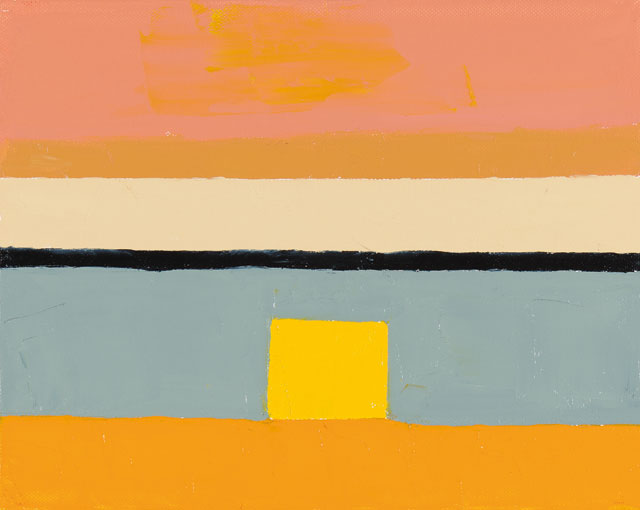
Etel Adnan. Untitled, 2010. Oil on canvas, 24 x 30 cm. Courtesy the artist and Sfeir-Semler Gallery, Hamburg / Beirut.
But aside from their intense, visceral response to colour, Klee and Adnan shared a preoccupation with war, loss and displacement – the focus of much of her poetry. She states in the exhibition guide: “I could discern a terrible anxiety in several paintings, even in bright ones. [Klee] was a man of the interwar period … When there were characters in his works, they were reminiscent of clowns or puppets; they were the dead of 1914-1918 or those of 1939-1940.”
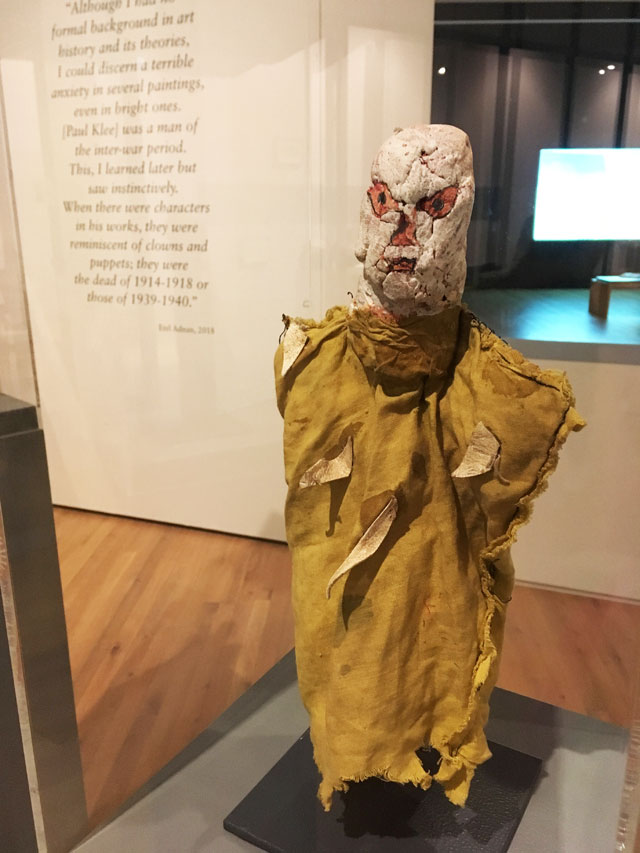
Paul Klee hand puppet. Photo: Veronica Simpson.
The show opens with a display of Klee’s hand-puppets, apparently made for his son Felix, although their faces are grotesque; masks of anguish and rage. They are accompanied by one of Adnan’s leporellos, an epic work, crammed with dense handwritten lines interspersed with pale watercolour markings. This is a book of her father’s story, made for the Istanbul Biennial, but there it was presented closed, because it mentions the Armenian genocide (the Ottoman government’s systematic extermination of 1.5 million Armenians, citizens of the Ottoman Empire, which began in 1915, and which Turkey still fails to acknowledge). Another leporello contains her Vietnam war poems, written in the 60s but transformed into this piece only in the 80s. There are also notebooks showing her early studies and sketches, which reveal an interest in Wassily Kandinsky as well as Klee.
The show then moves from this sombre space to one that reveals another enduring motif in Adnan’s art – her love affair with Mount Tamalpais in San Francisco, where she lived from 1958-72 and from 1977-2012, and which she could see from her apartment in Sausalito. On the righthand side are sketches of the mountain from the 70s, on the left are more recent watercolours. Nearby is another leporello, containing the poems she wrote to the mountain, which were then translated into Arabic. Here she uses her own words in their Arabic translation.
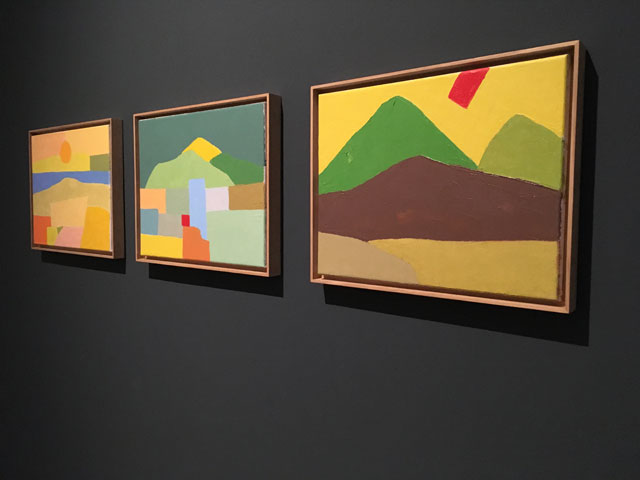
Etel Adnan. Untitled, 2014; Untitled 2016; and Untitled, 2012. Installation view. Photo: Veronica Simpson.
Three oil paintings are hung at the rear of this section, vivid against a contrasting, deep grey background: (Untitled, 2014; Untitled 2016; and Untitled, 2012). They are accompanied by a quote of Adnan’s: “Painters have the same knowledge mode as musicians. When someone plays the saxophone, the sky turns to copper. When you paint a watercolour, you know what the sea feels at daybreak as the light approaches. Painters have always known the unity of things, aware of the interferences and interventions between the world and ourselves.”
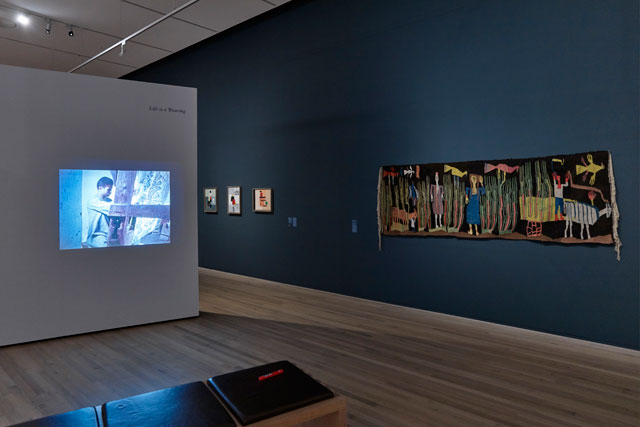
Etel Adnan. Installation view of Ismyrne, 2016 by artists Joana Hadjithomas and Khalil Joreige. Film HD, colour, sound, subtitles in English, 50 min. Photo: Rolf Siegenthaler.
Beside them, a grainy black-and-white film is screened: an experimental melding of analogue footage she took in the 70s in both San Francisco and New York, collaged together in the 80s, it is a particularly wonderful impressionistic exposition of her preoccupations. A waterfall and forest landscape sequence generates a real sense of the interplay of movement and structure, Earth as a living thing, the dynamic presence of rocks and trees and mountain – so sparely but eloquently articulated by the adjacent works serenading Mount Tamalpais. Her footage of New York focuses on its grid of buildings and streets, reflections of yellow taxis flowing down a street, like objects hurtling downstream; then we have a cat and clouds, sunset and sea; a visual tone poem.
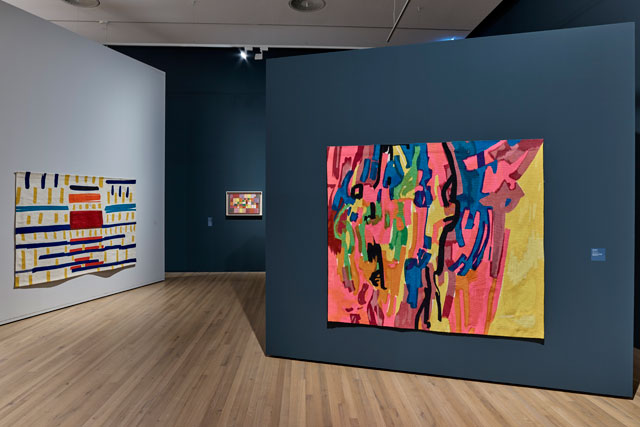
Etel Adnan. Tapestries, installation view. Photo: Rolf Siegenthaler.
Rounding the corner from this section, there is a burst of warmth and colour provided by a fantastic selection of the carpets and tapestries Adnan has mostly created very recently, facilitated by the sudden escalation in budgets and fame. Their inspiration is often from much earlier sketches: improvisational explosions of bright, magic-marker scribbles, transformed by hand into textiles in the finest workshops. Three new tapestries made in Paris by Aubusson are particularly splendid; they look as if they have been painted. Weaving is another passion sparked in the 60s by an encounter with the Egyptian architect Ramses Wissa Wassef, while travelling in Egypt; Wassef opened a weaving studio and encouraged youngsters to create their own improvised pieces. A film of him is included later in the show.
Next to the oldest tapestry, California 1977, there is a gorgeous Klee: a dense constellation of pale white and rose and red splashes, seemingly exploding out of a core of dark brown, russet and black. The juxtaposition of Klee and Adnan’s work is bold. Sometimes Adnan’s paintings are so clearly responding to Klee’s, but they are never eclipsed by his work. Rather, it is like when a jazz musician pays tribute to an iconic piece of music from someone he or she has studied deeply and admires intensely, colouring the structure laid down by their mentor with their own intonations and personality.
Towards the rear of the show there is an absorbing film, Ismyrne, by artists Joana Hadjithomas and Khalil Joreige. They interviewed Adnan in her Paris apartment, searching for traces of their families’ oral histories in Smyrna. There is something wonderful about Adnan’s aged finger caressing the vintage, monochrome map of Smyrna’s ancient streets, as her voice guides us through these dense, medieval neighbourhoods once occupied, quite amicably, by a large range of different migrant communities. Then the garishly coloured contemporary Smyrna map is laid before us as they search in vain for any remnants of the earlier streets, the current map’s DayGlo tones perfectly expressing that sweeping away of history for the sake of modernity; so many streets and properties gone, replaced by roads and concrete blocks.
This film – although not made for this show – skilfully probes the narratives that percolate throughout this exhibition: attachment to place, and its loss; the marking of moments in time. Like the works all around it, this is art as a form of bearing witness or, what Hans Ulrich Obrist once described as, “painting as a protest against forgetting”.